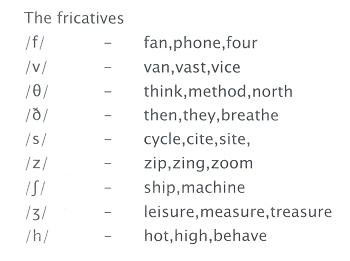English Pronunciation Index
Strong and Weak Fricatives :
Fricatives and plosives are obstruent speech sounds because they
involve the partial or total blocking of the vocal tract somewhere
along its length. This is in contrast to all other speech sounds, which
are grouped as the sonorants. Only the obstruents can be either
voiced or voiceless; all sonorants are voiced except in unusual cases
such as whispering or devoicing because of neighboring devoiced sounds.
Fricatives involve only partial blocking of the vocal tract, but the
opening at the point of maximum constriction is so narrow that turbulence
patterns develop from the passage of air through the constriction. This
turbulence is what we call frication. The strength of frication is
determined by the place of frication as well as the energy of the airstream
flowing through the opening. The strong fricatives s z S Z have more
energy than the weak fricatives v f D T for two reasons. First,
there is tighter constriction between the tongue and the alveolar ridge
(s, z) or the palato-alveolar region (S, Z) in the strong
fricatives than there is between the tongue and the teeth (T, D) or
the teeth and the lips (f, v) in the weak fricatives. Second, the
turbulent jets of air from the (palato-)alveolar fricatives strike the back
of the teeth and result in high-energy sibilance; in the
weak fricatives the jets of frication emerge directly into the air around
the speaker's mouth without any further modification. You can expect the
strong fricatives to show up more clealy on the spectrogram. Clues for weak
fricatives will be more subtle. Word initial weak fricatives may also look
very much like plosives in continuous speech, expecially f, D,
and T. This ``stop-like'' production does not seem to affect the
strong fricatives.


